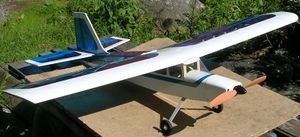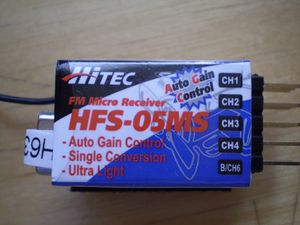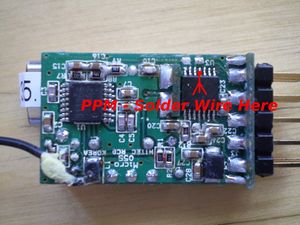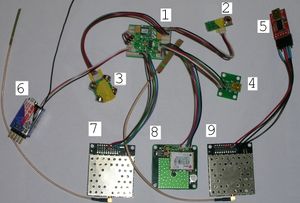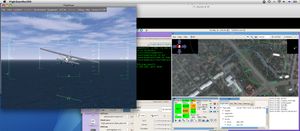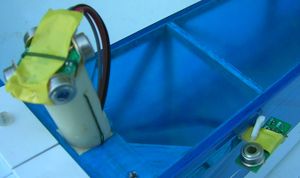Difference between revisions of "User:VAMK"
Allan Ojala (talk | contribs) |
Allan Ojala (talk | contribs) |
||
| Line 255: | Line 255: | ||
*I ordered for own amusement and for training purposes | *I ordered for own amusement and for training purposes | ||
===Parkfun Scout PF-205=== | ===Parkfun Scout PF-205=== | ||
[[Parkfunscout.jpg |thumb|center| | [[Parkfunscout.jpg |thumb|center| Parkfun Scout]] | ||
*Ready to fly plane. Completely factory assembled( except redder and elevator plane) with all electronics installed. | *Ready to fly plane. Completely factory assembled( except redder and elevator plane) with all electronics installed. | ||
*The package came with all the necessary parts: | *The package came with all the necessary parts: | ||
Revision as of 07:59, 8 August 2009
Vaasan Ammattikorkeakoulu - Vaasa University of Applied Sciences
Introduction
This page is part of a final thesis project made for Vaasa University of Applied Sciences. The idea in this project was to implement the Paparazzi hard and software to an RC airplane. The project began in June 2009.
The project is sponsored by WRD Systems
Hardware
The Plane
After a long period of choosing the plane, the Sig Kadet was chosen to be the one. Below are listed some characteristics why it was chosen.
- Big wing area (easier to control)
- Powerful electric engine (ability to take up extra payload)
- Light (fly weight about 700g)
- Semi-ready built (no balsa work)
In the process of choosing the plane the following properties of the plane had to be decided such as following just to name a few:
- plane type
- engine type
- engine size
There are several matters that needed to be taken into consideration when choosing the plane type. Different types of planes have different weight, dimensions, fuselage size, manoeuvring capabilities, maximum pitch angle, stall speed, wing tip design and so and so on... Just like there are thousands of different kinds of real airplanes, there also are thousands of different kinds of model airplanes available.
These model airplanes come in many types and sizes ranging in weight from a few hundred grams to several kilograms and in dimensions from a half meter wing tip size to even one meter. Some of the model are so called "ready-sets" these come with comfort of not having to build it yourself but have the down of being difficult to customize the others are semi-ready or DIY -models. We were glad to notice that there was plenty of room inside the plane to fit extra payload (the Paparazzi electronics). What we were looking for was an easy to build and fly aeroplane with enough power and space to carry some payload, the payload being the Paparazzi autopilot hardware that weighs about 300g.
Making decisions in purchasing an aeroplane is a win-lose situation. On all situations where you win there is always a downside where you lose. For example: a bigger engine brings power and speed but adds weight and either the fuel tank or the battery takes space also you can't fit a big engine in a small plane, more wing area brings more up-thrust and stability but adds air resistance thus hindering speed and losing power to win the drag.
If we had been looking for an airplane for just for flying that would have been easy but the choice was difficult because we needed the ability to carry payload and none of the RC models are designed to carry extra payload. Even if you can fit with extra payload and your plane being able to carry it, the balance point will be different from what the manufacturer has designed and if you started correcting it with extra balance weights you lose power because the plane has become heavier. It is not so disastrous if the extra weight is located near the nose of the plane but if you are forced to place it near the back then the plane becomes unstable. Adding extra payload to an already heavy plane doesn't have such a huge effect on balance than it would have on a light plane. For example: if you add 300g to a 3kg plane the new weight 10% greater than the original but if you had put the same weight in a 700g plane the new weight is about one and a half times as big as the old weight.
Choosing the radio controller is much simpler because they all basically work the same way and the only difference is the number of channels it can use. When choosing a radio controller, especially with Paparazzi in mind, make sure to buy a controller which has at least one more channel than the manufacturer recommends.
You can find SIG manufacturer site here.
Engine Type Comparison
Pros for electric engines:
- simple starting and stopping - can be turned on and off in mid air by just adjusting the throttle
- no dangerous liquids needed
- less noice than in combustion engines
- less vibration than in combustion engines
Cons for electric engines:
- useally less powerful than combustion engines
- charging the batteries needs much controlling especially Li-Po which also need a special charger
- charging takes more time than refueling a combustion engine
- different kinds of batteries need a different charger
Pros for combustion engines:
- powerful
- refueling is a quick procedure compared to charging batteries
Cons for combustion engines:
- vibration
- unable to restart engine while airborne
- hassle with fuel mixing and starting
Radio
- Hitec 6 Optic Sport
The receiver is also from Hitec, it's a HFS-05MS.
In order to use this one with Paparazzi, the PPM signal can be easily obtained as shown here:
Battery
- Li-Po 1300 mAh 11V.
Why Li-Po? "Li-Po batteries are light and small and have large storing capacity. As rule of thumb Li-Po batteries have four times the capacity compared to same sized and weighed Ni-Mh batteries".
Electronics
- TWOG autopilot
- Vertical infra-red sensor
- Horizontal infra-red sensor
- USB programming interface
- Base station USB/Serial interface
- HITEC HFS-05MS receiver
- Telemetry datalink AC4790
- GPS module
- Base station AC4790
Software
Used Programs and operating systems
All of the programs were run on Mac OS 10.5 and virtualized Ubuntu 8.04 on VMWARE Fusion 2.0.
A VMWare image containing Paparazzi as well as Wine+U-Control is available here. It is based on Ubuntu 8.04 LTS, but has most of the standard included tools and sofware removed.
Linux
Mac
Simulation Example
In the screenshot you can see a Paparazzi GCS run on Ubuntu in a virtual machine and Flight Gear run on Macintosh. The navigation signal is broadcast in the local area network using UDP.
The reason why there's no land under the plane is that there were no landscape textures loaded into the Flight Gear at that moment.
How to Launch Simulation
Check the Paparazzi Wiki here.
Here's is an Applescript shorcut for Mac users to launch Flight Gear to see the simulation.
tell application "Terminal" to activate
try
tell application "System Events"
keystroke "cd /Applications/FlightGear.app/Contents/Resources"
keystroke return
keystroke "./fgfs.sh --fdm=null --native-gui=socket,in,30,,5501,ud"
keystroke return
end tell
on error
display dialog "Error: could not launch FlightGear. Is it installed? Please download and install FlightGear to Applications folder." buttons {"OK"} default button 1
set download_url to "http://www.flightgear.org/Downloads/binary.shtml"
open location download_url
end try
The run this open Script Editor from /Applications/AppleScript copy paste above code and compile and run. To save it as an executable you must "Save As" and click the "Run Only" to true.
Configuration
Log
Thursday 11.th June 2009
- Obtained all plane parts including radio and chargers
- Visited Vaasan lentokerho (Vaasa flight club) for final advives about what I should take special care when building the plane.
List of items:
- Atala-RC fly battery 11V 1300mAh
- Graupner "Ultramat" Ni-Mh and Li-Po fly battery charger with cell balancer feature
- Hitec Optic-6 Sport radio ( included 3 HS-55 micro servos )
- 1 micro servo HS-55
- SIG Kadet
- Graupner fly battery contactors
Friday 12.th June 2009
- Started constructing the plane
Assembled
- wings
- ailerons
Saturday 13.th June 2009
- installed two servos on wings
- installed two servos inside the fuselage
I had to extend cabels of one of the servos on the wings
Sunday 14.th June 2009
- assembled elevator
- cut pushwires to correct lengths, bend pushwire ends and connected them to servos.
Monday 15.th June 2009
Installed:
- receiver
- engine
- engine controller
- propeller
- cowling
The plane was now finished. The constructing took about 40 hours. Most of the time went to fecthing tools, reading the manual and waiting for the epoxy glue to dry,
Tuesday 16.th June 2009
Showed the newly build plane to members of the flight club. They noticed the battery connectors should be have reverse for safety reasons. I had soldered male to battery which should have been in the wires of the engine controller.
Wednesday 17.th June 2009
- re-soldered battery connectors
- smoke test
Results: no smoke, radio works. engine runs one servo did not work. Noticed that there didn't come wires or adapters to connect the battery to the charger.
Thursday 18.th June 2009
- Solved lack of wires or adapters problem with sacrificing test leads from a multimeter and modifiying their heads to fit the Graupner connectors.
- Solved why one of the servos did not move. The reason why it did not work was that its channel (channel 5) where it was connected had to be programmed from the radio for it work.
Saturday 20.th June 2009
- Further programming the radio.
Monday 21.st June 2009
- Meeting with supervizing teacher.
- Shortened one of the pushwires on wings.
- Test flight
- Investigated damage
- broken engine axel
- busted cowling
- scracth in propeller
- Order spareparts from SIG.
- engine
- cowling
- propeller
- started doing this Wiki.
Result: Landing in high grass broke axel and cowling also damaged propeller.
Tuesday 23.rd June 2009
- improved battery connector insulation
- simulator training for two hours
Wednesday 24.th June 2009
- Documention
Thurday 25.th June 2009
- Simulator training.
Friday 26.th June 2009
- Gave the plane to supervzing teacher for Paparazzi electronics installation.
Tuesday 30.th June 2009
- Simulator training
Wednesday 1.st July 2009
- Meeting with supervizing teacher at Technobotnia
- Build a wooden swing to test IR sensors.
- Started writing a C demo about #define macro dangers.
Thurday 2.nd July 2009
- Taking and uploading photos to wiki.
- Finished the C demo.
- Flight club meeting.
Friday 3.rd July 2009
- Prepared virtual machine for IR testing.
Saturday 4.th July 2009
- Setup IR test site outside
Test cancelled due rain.
Sunday 5.th July 2009
- Planned placement of circuits into the plane
Monday 6.th July
A rainy day, not possible to do tests outside.
- Improved testing board by making better fastening for circuits.
Tuesday 7.th July
- First proper IR test day.
Results: Tilting the horizontal IR circuit didn't seem to have any effect. The vertical sensors seem to work. Plan: Check IR settings from XML file configuration.
Wednesday 8.th July
- Parts from SIG arrived
- Mounted a modified propeller adapter to old broken axel and installed new propeller on it. Improvisation was the name of the game because I received a brushed engine instead of a brushlees engine.
- The new cowling did not have ready holes for the axel and so I had to drill cut holes for it and for the fastening screws.
- Discovered the reason for IRs not having any effect: the zero level was not set properly.
- Followed the tuning guide for checking the zero level.
- Tried building and uploading with new settings. Problem: the system stopped responding and started complaining that the system is "lost".
Thursday 9.th July
- After a new build and upload the system was still "lost".
- After several trials and errors and discussing in paparazzi IRC chat room I discovered the reason for the build failure.
- Before every new build a clean must be executed. I failed to do this and so the build did not work.
Thursday 16.th July
- Fastening various paparazzi circuits to the plane. No glue used all parts can taken unfastened with a screwdriver.
Friday 17.th July
- Noticed that not all wires were all long enough to reach their fastening places when trying to put all pieces together.
18.th July - 1.st August
- I took part in IPEAI - The Intensive Programme on Embedded and Ambient Intelligence in Kiel Germany.
4.th August
- Meeting with supervizing teacher
- I made some changes to XML the day before but could not execute anything. Problem was that I lacked the needed processes from the seession and that's why it didn't do anything.
- Earlier I wanted to extend the sensor wires but was no-go because if we had extended the wires the signal from the sensors would have suffered. Now I will have to make a tower for the sensors like in here.
- Personally I don't like the idea of a tower because of aerodynamic, aesthetics and balance reasons. Well it can't be helped so tower it is.
Building of the "tower":
- The tower is made of 25 mm diameter white plastic pipe and on top of it is the horizontal sensor.
- I maneged to put the vertical sensor to the side after the wing where originally planned.
- Also I noticed I will need an extral level above the two servos inside the fuselage to place the circuit board so that it won't short circuit from the pushwires.
- I tried to build it from balsa. The tower was good and the balsa was very easy to work with but the problem was where to route wires back inside the plane :).
5.th August
- Rebuilt the tower from yesterday ( it wasn't straight ).
- The yellow tapes on the sensors are expensive special tape with very high resistance. Protects the circuits from static discharges while working with them.
- The vertical sensor snaps into place in the plastic holder.
- The horizontal sensor is attached to the top with double nylon string. Sounds silly to attach with string but it fealt very sturdy and it can be taken away if needed.
Other activities:
- Remaking a piece of C-code that handles the mode changes.
6.th August
- planning and testing a flightplan
7.th August
- Solving the "Low-Battery" -warning I think it is fixed now.
- Received the parts for MY OWN RC plane from Karkkainen
8.th August
- Build my own RC plane: Parkfun Scout PF-205
- I ordered for own amusement and for training purposes
Parkfun Scout PF-205
- Ready to fly plane. Completely factory assembled( except redder and elevator plane) with all electronics installed.
- The package came with all the necessary parts:
- 4 - channel Parkfun PF-4X radio ( no batteries included )
- 4 - channel receiver
- 4 servos
- Li-Po battery 11.1V 1350 mAh
- Automatic balance Li-Po charger
- Powerful brushless engine and an ESC
- USB flightsimulator interface cable
- FMS flightsimulator
| Technical Specifications | |
|---|---|
| Wingspan | 1180mm |
| Length | 830mm |
| Weight (according to manual - feels much heavier) | 580g |
| E-motor | Brushless 180W |
I put it together in about an hour.
Price: 185€ + 7€ shipping to home door
Delivery time: 2 days
From: karkkainen
The simulator is OK and the plane was very fast easy to put together. The package included everything so no time wasted googling every place for the best bargain etc.
